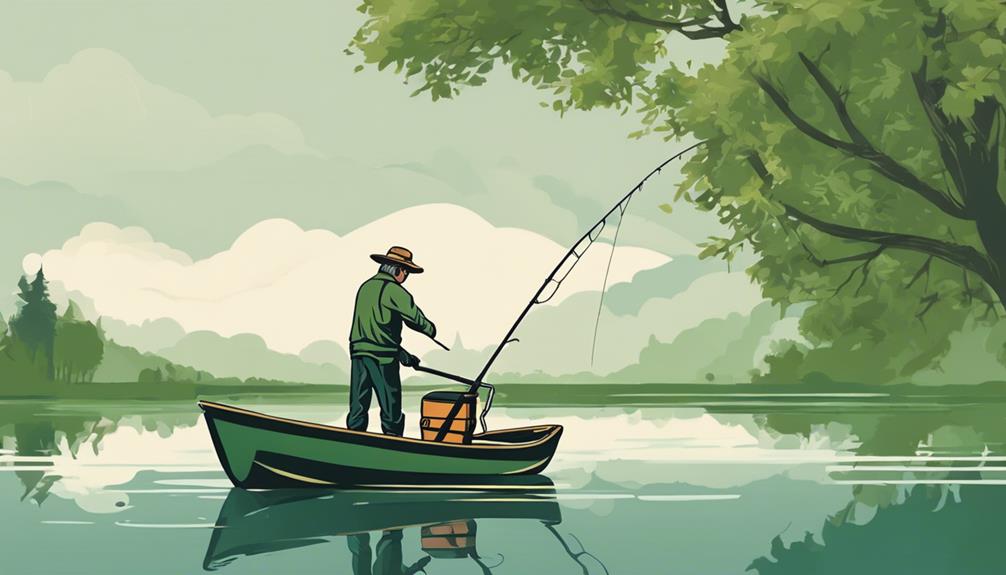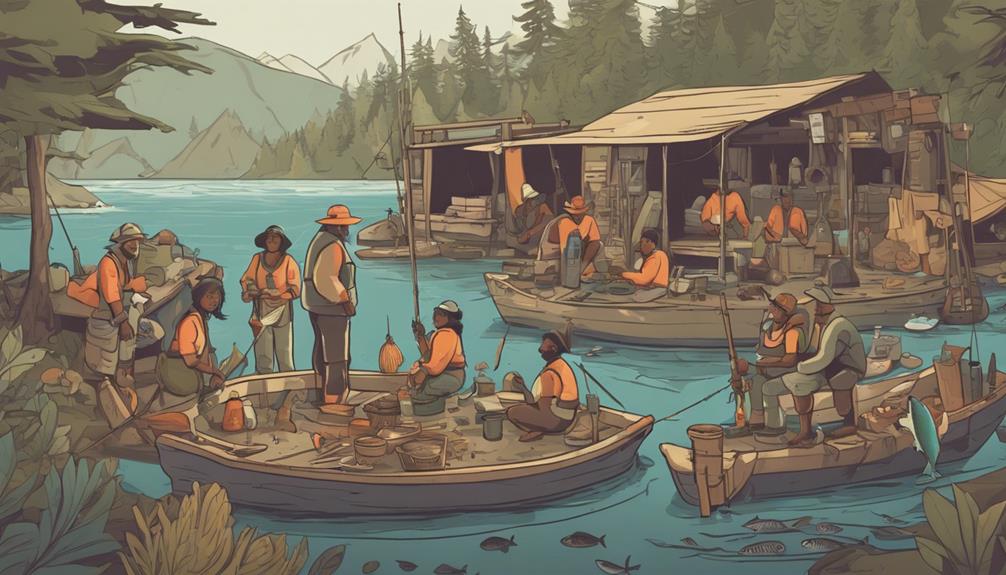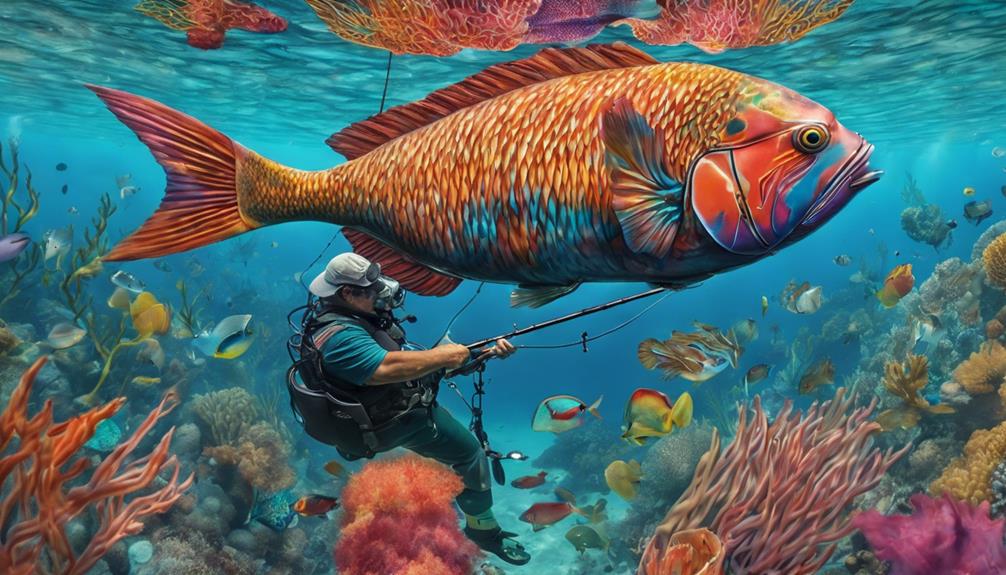When it comes to summer fishing, targeting specific species successfully is like solving a puzzle – each fish requiring its own unique approach. From the elusive bass hiding in the depths to the cunning walleye lurking near structures, mastering the techniques for different species can be a rewarding challenge. Understanding their behaviors and habitats is key, but there's more to it than just that.
By fine-tuning your tactics and gear, you can significantly increase your chances of landing that prized catch.
Bass Fishing Techniques in Summer
When fishing for bass in the summer, remember to adjust your tactics based on their behavior in warm water. Bass tend to be more active in the early morning and late evening when the water is cooler. During these times, using a topwater frog lure can be highly effective. The topwater frog mimics a frog swimming on the surface, enticing bass to strike. Cast the frog near lily pads or other vegetation where bass are likely hiding, and use a twitching motion to make it look realistic.
As the day progresses and the sun beats down, bass often move to deeper water to escape the heat. This is when deep cranking becomes a valuable technique. Deep cranking involves using crankbaits that can reach depths where bass are holding. Choose crankbaits with a larger bill to dive deeper and opt for colors that imitate the local baitfish. Cast your crankbait towards drop-offs, submerged structures, or points where bass may be congregating.
Trout Fishing Tips for Hot Weather
During hot weather, trout fishing requires adjusting your approach to account for the fish's behavior in warm conditions. Trout tend to be more lethargic and seek out cooler, oxygen-rich waters, making them a bit trickier to catch during the summer months. To improve your chances of success, consider the following tips:
- Use Lightweight Gear: Opt for lighter tackle and equipment to prevent stressing the fish during the fight in warmer water.
- Fish Early or Late: Target trout during the cooler parts of the day when they're more active, such as early morning or late evening.
- Focus on Deep Pools: Trout often seek refuge in deeper pools or shaded areas to escape the heat, so concentrate your efforts in these spots.
- Try Fly Fishing: Switch to fly fishing techniques, as the delicate presentation and natural movements of flies can entice even sluggish trout.
- Employ River Techniques: Utilize river fishing techniques like drift fishing or nymphing to cover more water efficiently and present your bait naturally.
Targeting Catfish in Warm Months
To target catfish during the warm months, adjust your fishing strategy to account for their behavior in higher temperatures. When the sun is blazing and waters are warm, catfish tend to be more active during the cooler parts of the day. Utilize nighttime catfishing tactics to increase your chances of a successful catch. Catfish are known to be more active at night, feeding more actively under the cover of darkness. Consider setting up your fishing spot later in the evening and into the night for optimal results.
Live bait strategies can also significantly improve your catfishing game during the summer months. Catfish have a strong sense of smell and are attracted to live bait such as worms, minnows, or even chicken liver. Using live bait can entice catfish to bite and increase your chances of a successful fishing trip. Make sure to present your live bait properly, ensuring it looks natural in the water to attract the attention of catfish effectively.
Strategies for Catching Walleye in Summer
In the warm summer months, focusing on specific techniques and bait selection can enhance your ability to catch Walleye efficiently. When targeting Walleye during the summer, it's essential to understand their behavior and adjust your strategies accordingly. Here are some key tips to improve your chances of landing a prized Walleye:
- Walleye Hotspots: Look for Walleye in areas with structure such as rocky points, underwater humps, and weed beds. These locations provide cover and attract baitfish, making them prime feeding grounds for Walleye.
- Summer Walleye Baits: Experiment with a variety of baits to entice Walleye during the summer months. Consider using live bait such as minnows or leeches, as well as artificial lures like crankbaits, jigs, and spinners. Changing up your bait presentation can help trigger more strikes.
- Adjust to Low Light Conditions: Walleye are known for being more active during low light periods such as early morning, late evening, and cloudy days. Plan your fishing trips accordingly to capitalize on these optimal feeding times.
- Trolling Techniques: Trolling can be an effective method for covering a large area of water to locate schools of Walleye. Experiment with different trolling speeds and depths until you find the most productive setup.
- Be Patient and Persistent: Walleye can be finicky at times, so patience is key. Keep trying different techniques and locations until you find success. Remember, persistence often pays off in the world of fishing.
Summer Tactics for Snapper Fishing
For successful summer snapper fishing, focus on targeting specific locations with the right bait and techniques. Snapper are often found near underwater structures like reefs, wrecks, and ledges, so concentrate your efforts around these areas. When using bait, opt for live offerings such as shrimp, squid, or small fish to entice snapper effectively. Additionally, consider employing jigging techniques to mimic injured baitfish and attract snapper to your line.
To enhance your summer snapper fishing experience, draw inspiration from tarpon fishing strategies. Tarpon are known for their strength and agility, requiring anglers to use sturdy equipment and maintain a firm grip during the fight. Similarly, when targeting snapper, ensure your gear can withstand the fish's powerful runs and sudden movements to prevent break-offs.
Moreover, incorporate marlin techniques into your snapper fishing arsenal. Marlin fishing often involves patience and precision when setting the hook to secure a successful catch. Apply this principle to snapper fishing by waiting for the right moment to set the hook firmly and reel in your prized snapper.
Successful Summer Pike Fishing Methods
When targeting pike during the summer months, focus on utilizing jerkbaits and spinnerbaits for optimal success in your fishing endeavors. Pike are known for their aggressive nature, making them a thrilling catch for any angler. To enhance your summer pike fishing experience, consider the following tips:
- Pike lure selection: Choose lures that mimic the movement of injured fish to trigger pike strikes. Opt for bright colors and larger sizes to attract these predatory fish.
- Casting techniques: Practice accurate casting near weed beds, rocky areas, and other structures where pike tend to hide. Work your lure along the edges of these spots to entice strikes.
- Summer pike hotspots: Target shallow bays, points, and areas with submerged vegetation as pike are often found in these locations during the warmer months.
- Time of day fishing: Early morning and late evening are prime times for pike fishing in the summer. These periods coincide with low light conditions when pike are more active.
Redfish: Best Summer Fishing Approaches

During the summer months, targeting redfish calls for employing versatile bait options to maximize your fishing success. Redfish are commonly found in coastal waters, making them a popular catch for summer anglers. To increase your chances of landing a redfish, it's essential to know where to find them. Look for redfish hotspots such as shallow flats, mangrove shorelines, oyster bars, and grassy areas with good water flow.
When it comes to summer bait options for redfish, live bait can be highly effective. Consider using live shrimp, mullet, pinfish, or mud minnows to entice redfish to bite. Another successful bait choice is cut bait such as mullet or menhaden. Artificial lures like spoons, soft plastics, and topwater plugs can also attract redfish, especially during low light conditions or when they're actively feeding.
To target redfish successfully in the summer, adapt your fishing techniques based on the time of day and the water conditions. Early mornings and late evenings are prime times to catch redfish as they're more active during these cooler periods. Pay attention to the tides and currents, as redfish tend to feed more aggressively during moving water.
Summer Flounder Fishing Secrets
Uncover the hidden strategies for successful summer flounder fishing. When targeting summer flounder, also known as fluke, it's crucial to have the right tactics in place to increase your chances of a successful catch. Here are some tips to enhance your summer flounder fishing experience:
- Flounder Baiting Strategies: Opt for live bait such as minnows, squid, or spearing to attract flounder effectively. Using a bucktail jig with a teaser above it can also mimic the movement of smaller fish, enticing flounder to bite.
- Flounder Tackle Recommendations: Choose a medium to medium-heavy rod around 7 to 8 feet in length paired with a spinning reel that can handle 10-20 pound test line. Fluorocarbon leaders are essential to prevent the sharp teeth of flounder from cutting your line.
- Focus on Structure: Look for areas with sandy bottoms near structures like rocks, wrecks, or reefs. Flounder often hide around these structures, waiting to ambush prey.
- Adjust Your Technique: When you feel a bite, give the flounder a moment to fully take the bait before setting the hook. Flounder have a tendency to nibble before committing to the bite.
- Patience is Key: Summer flounder can be finicky, so be patient and persistent. Allow time for the flounder to inspect and strike your bait properly.
Frequently Asked Questions
What Types of Bait Are Best for Targeting Specific Species During the Summer Months?
For targeting specific species during summer months, the best bait varies. Live bait can be effective for species like bass, while artificial lures work well for trout.
Fly fishing is great for species like salmon, and trolling techniques can attract walleye.
Experiment with different baits and techniques to see what works best for the species you're targeting. Remember to consider the habits and preferences of the fish you're trying to catch.
How Important Is It to Consider the Water Temperature When Fishing for Different Species in the Summer?
Considering water temperature when fishing in the summer is crucial for success. It directly impacts the behavior and location of different fish species. Warmer waters may push certain fish deeper, while others prefer cooler spots.
Are There Any Special Techniques for Targeting Specific Species During the Early Morning or Late Evening in the Summer?
When targeting specific species during the early morning or late evening in the summer, you can enhance your success with night fishing techniques and special lures.
Summer patterns dictate that late afternoon can also be a productive time to fish. By adjusting your approach based on these factors, you can increase your chances of catching your desired species during these times of the day.
What Are Some Common Mistakes That Anglers Make When Fishing for Specific Species in the Summer?
When fishing for specific species in the summer, common mistakes can lead to missed opportunities. Correct techniques are crucial to avoid these errors.
Pay close attention to your gear, as using the wrong bait or tackle can deter bites. Inadequate knowledge of the fish's behavior and habitat may also result in unsuccessful outings.
Stay informed and adaptable to increase your chances of a successful summer fishing experience.
How Does Weather Patterns, Such as Rain or Wind, Affect the Behavior of Different Species During the Summer?
Weather patterns like rain or wind can significantly impact fish behavior in the summer. The changing conditions can affect fish feeding habits and their movement patterns.
For example, heavy rain may increase water flow and turbidity, making it harder for fish to locate prey. Conversely, windy conditions can create choppy waters, making it challenging for fish to feed near the surface.
Understanding these factors can help you adapt your fishing techniques for success.
Conclusion
Now that you have learned specific techniques for targeting different species in the summer months, you're well-equipped to have a successful fishing season.
Remember to adjust your strategies based on the behavior and preferences of each species, and don't be afraid to experiment with different tactics.
With patience and perseverance, you can reel in some impressive catches and make the most of your summer fishing adventures.
Happy fishing!



